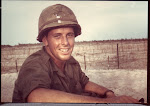KANDAHAR AIR FIELD, AFGHANISTAN: Over the last year the Afghan Air Force detachment here at Kandahar Air Field has doubled in size and greatly improved. With the addition of C-130s and C-27s, a fixed wing group has been added. The C -27s are similar to the C-123s from the Korean and Vietnam eras but with Turbo prop engines. There are six MI-17 Russian built helicopters permanently stationed here as well. This morning’s flight will be in one of these basic but rather extraordinary aircraft.
Afghan Helicopter MI-17 after landing in the mountains near the Redgistan Desert
“I’m a Huey pilot these days,” said Lt. Col. Fred Koegler. “These aircraft are the Russian version of a Huey, just much larger.” The Lt. Col. will be the chief pilot on today’s training mission which will take place southwest of Kandahar over portions of the Redgistan Desert, and the mountains that run along its western border. This vast span of red sand covers 10,000 square miles.
The weather is 81 degrees F., visibility is good, the winds light, 05 is the active runway as Lt. Col. Koegler taxis the Afghan chopper along the taxiway parallel the active runway. The aircraft speeds up and climbs out quickly in the direction of the Red Desert.
Col. Michael Outlaw is the co-pilot and Tech. Sgt. Jason Stitt the instructor gunner round out today’s crew. Col. Outlaw is in the right seat in order to make the required flight hour requirements to remain current in the MI-17. There would ordinarily be an Afghan co-pilot. Also on board are Flight Engineer Sher Gan, two trainee crew chiefs, Faiz Mohammad and Powlat Khan and Shari the interpreter.
Within a few miles from the Khandhar area, there are no roads, power lines, vehicles or any evidence of a modern society. From an altitude of a thousand meters all that’s visible is Bedouin shepherds, their tents, and their goats and camels….a scene from another age.
The MI-17 makes a number of landings in the desert with the crew chiefs looking out both sides as the aircraft nears the ground, to look out for sand bursts that might blind the pilot before his final touchdown. Other landings are made in the high peaks in tight places where level landing zones are difficult to find. These mountains must be accessible to helicopters both for armed attacks against insurgents and for rescue of American or Afghan GIs who could be injured in operations there.
L to R: Col. Michael Outlaw and Lt. Col, Fred Koegler departing aircraft after training flight
After returning to the field and landing, Lt. Col. Koegler again stresses the importance of the crew chiefs carefully watching both sides of the helicopter as it comes in for a landing. “The rotor on a MI-17 is 63 ft in diameter,” he said. “We land in tight spots on the many FOBs (forward operating bases) and COPs (combat outposts) that are supplied daily by helicopters. Every kind of obstacle is to be expected and obviously avoided. You all saw how tight it was on that small LZ (landing zone) in those mountains.”
Afghan Air Force ground crew securing aircraft after landing
A thorough de-briefing was held in the Afghan compound conference room after the flight. The Afghan Air force flight crews are capable, serious students but if they are to take over the mission now preformed by the US Air Force here in Afghanistan, they have a long road ahead. The US Command does not allow Americans as passengers aboard an aircraft with an all Afghan flight crew.




No comments:
Post a Comment